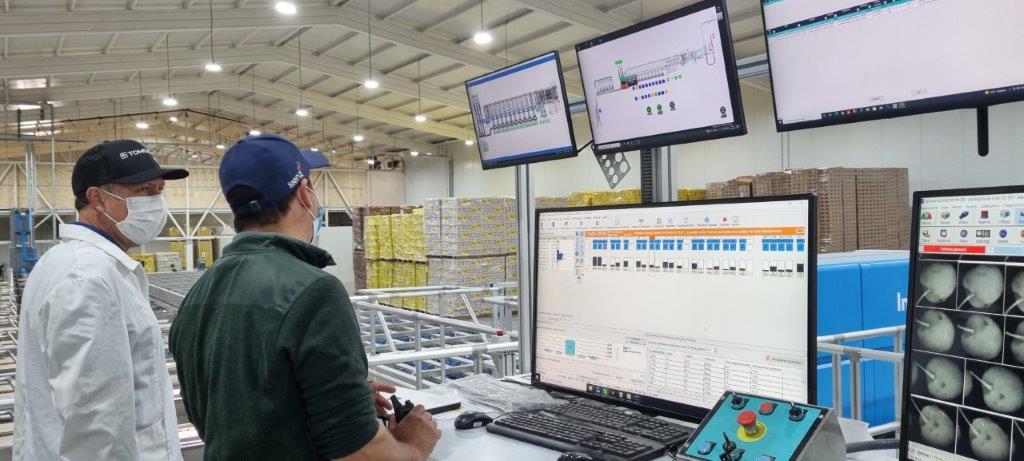Belgium-based TOMRA Food and Recycling recently tackled the topic of “digital transformation,” explaining how fast change is happening in packinghouses and processing facilities around the world.

TOMRA noted that when it refers to digital technologies, “… we mean electronic tools or automated systems that generate store, and process data. These technologies are developing so quickly that a ‘second wave’ of digital transformation is currently sweeping through industries, bringing robotics, big data, artificial intelligence, and machine learning.”
It said, “There is more to digital transformation, however, than technology. It’s also a cultural change. A mindset. A willingness by businesses to recognize that they could be doing some things better and open-mindedness to digital technologies to enable the targeted improvements.”
To that end, TOMRA continued, “The industry is poised to take its biggest step forward since automated sorting machines replaced manual sorting. Once again, it is automated sorters that are making the leap possible.”
While some food processors and packinghouses might think digital transformation has nothing to do with them, the fact is that digital technologies are developing rapidly.
With the industry “poised to take its biggest step forward since automated sorting machines replaced manual sorting,” TOMRA said it is “automated sorters that are making the leap possible.”
It continued, “The industry leader in sorting, grading, and packing solutions, TOMRA Food, has been on its digital transformation journey for five years. Knowing that digital solutions will be a key enabler of efficient food production – and that reducing food waste is becoming increasingly important, both for economic and environmental reasons – TOMRA has committed considerable effort to build the foundations of its first digital technologies to support customers.”
This has resulted in a number of advancements: TOMRA’s Digital Operations Center; TOMRA Remote Assist for technical support; the TOMRA Visual Assist Augmented Reality tool; and the TOMRA Insight customer portal and data platform. This foundation also serves as the basis to offer artificial intelligence and deep learning solutions for TOMRA Food’s sorting and grading equipment.
TOMRA’s Digital Operations Center can remotely monitor equipment to provide customers feedback if unusual behavior is observed. Taking this one step further, TOMRA Remote Assist enables TOMRA service engineers to log into the customer’s machine remotely to provide faster technical support, eliminating or reducing downtime.
And going another step further, TOMRA Visual Assist is an easy-to-use app that enables TOMRA’s remote experts to provide specialist support to a customer or service engineer just as if they were standing in front of the customer’s machine. This makes it possible to solve broad-ranging problems of different complexity remotely.
The TOMRA Insight customer portal and data platform are cloud-based and available by subscription. This automatically extracts data from sorting machines and presents it in easy-to-understand graphics. Information about materials passing through the machines can be seen and responded to in real-time on the machine user’s touchscreen, enabling instant improvements in line efficiencies and product consistency.
“Businesses that rely on precise, objective data – rather than merely depending on experience and instinct – make better-informed operational and strategic decisions,” TOMRA said.
“The first example is a processing and packaging center for vegetables. This was wrestling with an incoming defect level of 42 percent, mostly because of vegetables that were too short to meet agreed product specifications. Over six working days, some 150 million ‘short’ defects were ejected from the line. The good-in-bad ratio of rejected materials was 1.8, meaning that 18.75 million good and saleable objects (with a total weight of 1,250 tons) were thrown away. With material saleable at $20 per ton, that was a €25,000 loss of potential revenue in just six days.”
By addressing this problem through TOMRA Insight, “it was possible to identify the need for a new mechanical remover before the sorter – and this reduced good-in-bad losses by 90 percent, increasing revenue by $22,000 per week,” the company said.
“The second example, at a fresh packer, shows how TOMRA Insight was used to check whether the belt distributor and material infeed were working optimally. Data taken over two weeks showed that one side of the belt was overloaded. Some nine million objects (with a total weight of 315,000 kilograms) were ejected during this period. TOMRA Insight revealed that the good-in-bad ratio was 10 percent. To spread the load equally, TOMRA used TOMRA Insight to monitor ejections and identify required actions. The result was a reduction in good-in-bad-losses worth €5,600 in two weeks, equivalent to adding €145,600 to the bottom line annually.”
A third example, also at a fresh packer, “shows the value gained from monitoring and reacting to incoming product quality. Here the incoming defect level was expected to be 10 percent, but TOMRA Insight revealed it to be significantly higher, at 16 percent.”
For additional information, visit TOMRA at https://www.tomra.com/ . The full release on TOMRA’s digital transformation can be downloaded at https://1607495.fs1.hubspotusercontent-na1.net/hubfs/1607495/PR/Digital%20Transformation/TF-2023-PR-DigitalTransformation.pdf?utm_campaign=TF-2023-PR&utm_medium=email&_hsmi=261177738&_hsenc=p2ANqtz-_Cl4HB91_uIV-i7wJbFRwjLyYYzmPeYHIk54ufGDUntiFi1F8HBWa0OE1k9WWe4xMV1y8XWHJ_tdUh3Qs45AYNwJPwJU0WjdidbSXmAcir6Dud5ko&utm_content=259639456&utm_source=hs_email


